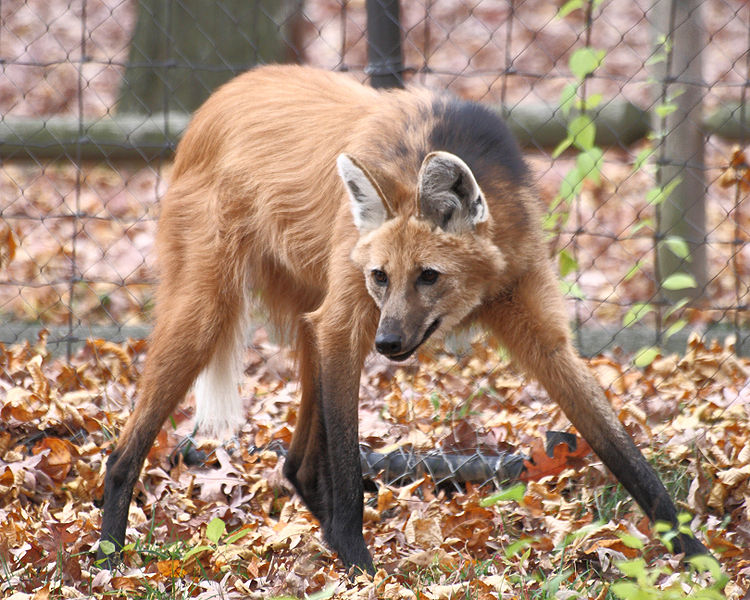This Wolf is Literally Threatening!

Classified by the International Union for the Conservation of Nature and Natural Resources as “near threatened” to extinction and by agencies of the Brazilian government as “vulnerable,” the maned wolf is in danger. Currently, the population of maned wolves is about 13,000 mature organisms, which lists the animal as near threatened, and the population expected to decrease about 10% in the next 10 years. This decline is largely due to humans, for we are ruining their habitat, killing them on roads, and killing them in many other ways (Rodden, et al. 2008). Even though maned wolves don’t have any natural enemies, they are still in excessive danger (nationalzoo.si.edu).
The extreme loss of habitat is the largest threat to maned wolf
populations. The habitat is being reduced because humans are
transforming the land to farming and ranching land in this region
(wwf.panda.org, Rodden, et al. 2008). (Go to Habitat) Added to that,
"habitat fragmentation causes isolation of subpopulations" (Rodden, et al.
2008). In a study done by Lion, et al., by testing the DNA of 23
maned wolves, they studied the
genetic diversity of the organism. Their results claimed that none of the populations they studied
showed
signs of inbreeding or differences from what was expected using the Hardy-Weinberg
principle. There was not a decrease in genetic diversity, and the
genes are exchanging between maned wolves at well enough rates to avoid differentiation. In conclusion, the fragmentation in
the cerrado has not impacted the genetic diversity
of maned wolves (Lion, et al. 2011). In another study done by a
researcher at Brazil’s Goias State University, it was concluded that maned
wolves can adjust well to habitat fragmentation compared to other
great sized predators (Roy 2004).
Interactions with humans also pose a threat to the maned wolf. (Go to Interactions) Because highways border the Brazilian cerrado, and most drivers do not follow the speed limits, an abundant amount of maned wolves are killed on the roads by vehicles (Rodden, et al. 2008). Each year approximately two pups per litter are killed by cars and trucks (Roy 2004). Maned wolves were once killed by farmers because they were thought to be a threat to livestock; however, in reality, they are only a threat to poultry. As a result chicken farmers are known to kill the maned wolves. Lastly, humans hunt maned wolves for some of their body parts, which are believed to have magical powers, and for food (denverzoo.org). It is said that the right eye of the maned wolf can bring good luck in gambling, and if children wear a necklace with a maned wolf tooth on it, they will not have future dental problems. The animal’s fur is used by the native South American people for religious ceremonies. The use of maned wolf body parts for medical purposes is restricted only to native folk medicine and does not take part in large-scale commercial industries (Rodden, et al. 2008).
Another threat to the organism’s survival is domestic dogs. These animals sometimes chase and kill maned wolves in habitats close to urban areas. The local dogs may also pass on disease, for the problem of diseases in maned wolves is much higher in areas where there are domestic dogs (wwf.panda.org, Rodden, et al. 2008). (Go to Interactions).
 The maned wolf’s guarded lifestyle
makes it difficult to determine all of the elements it
requires to survive. Conservative
actions have been put in place. The maned wolf is included on the
list of threatened animals in Brazil and on the Endangered Species
list in the United States. Additionally, hunting is illegal in
Brazil, Paraguay, and Bolivia, and maned wolves are protected by law
in Argentina, Bolivia, Brazil, Paraguay, and Peru. Efforts to
protect a wider-range, such as the cerrado, have also been placed,
and an example of this would be current
actions to decrease the amount of road kills (Rodden, et al.
2008). In the 1990’s laws were passed that forced landowners to
keep at least 20% of their land as natural habitat. With the help
of satellite photos of the cerrado, government authorities are able
to monitor
and impose this law (Roy 2004).
The maned wolf’s guarded lifestyle
makes it difficult to determine all of the elements it
requires to survive. Conservative
actions have been put in place. The maned wolf is included on the
list of threatened animals in Brazil and on the Endangered Species
list in the United States. Additionally, hunting is illegal in
Brazil, Paraguay, and Bolivia, and maned wolves are protected by law
in Argentina, Bolivia, Brazil, Paraguay, and Peru. Efforts to
protect a wider-range, such as the cerrado, have also been placed,
and an example of this would be current
actions to decrease the amount of road kills (Rodden, et al.
2008). In the 1990’s laws were passed that forced landowners to
keep at least 20% of their land as natural habitat. With the help
of satellite photos of the cerrado, government authorities are able
to monitor
and impose this law (Roy 2004).
There are gaps in the information on maned wolves which are preventing us from protecting the organism. Studies on the population throughout the range are needed, along with research on the effect of human invasion on the habitat, how well maned wolves can live on farmed land, and the impact of diseases on the organism. These factors need to be investigated and better understood in order to improve the conservation of the species (Rodden, et al. 2008).
Back to HOME
